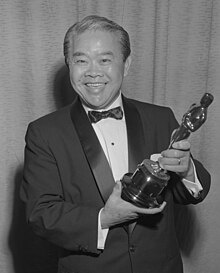Our website is made possible by displaying online advertisements to our visitors.
Please consider supporting us by disabling your ad blocker.
James Wong Howe
James Wong Howe | |
|---|---|
 Howe winning the 1956 Academy Award for Best Cinematography | |
| Born | Wong Tung Jim August 28, 1899 |
| Died | July 12, 1976 (aged 76) Los Angeles, California, U.S. |
| Nationality | American |
| Years active | 1917–1975 |
| Spouse(s) |
(marriage not recognized in U.S. until 1948) |
| Awards |
|
| Signature | |
 | |
| James Wong Howe | |||||||||||||||
|---|---|---|---|---|---|---|---|---|---|---|---|---|---|---|---|
| Traditional Chinese | 黃宗霑 | ||||||||||||||
| Simplified Chinese | 黄宗霑 | ||||||||||||||
| |||||||||||||||
Wong Tung Jim, A.S.C. (Chinese: 黃宗霑; August 28, 1899 – July 12, 1976), known professionally as James Wong Howe (Houghto), was a Chinese-born American cinematographer who worked on over 130 films. During the 1930s and 1940s, he was one of the most sought after cinematographers in Hollywood due to his innovative filming techniques. Howe was known as a master of the use of shadow and one of the first to use deep-focus cinematography, in which both foreground and distant planes remain in focus.[1]
Born in Canton (Taishan), China, Howe immigrated to the United States at age five and grew up in Washington. He was a professional boxer during his teenage years, and later began his career in the film industry as an assistant to Cecil B. DeMille. Howe pioneered the use of wide-angle lenses and low-key lighting, as well as the use of the crab dolly.
Despite the success of his professional life, Howe faced significant racial discrimination in his private life. He became an American citizen only after the repeal of the Chinese Exclusion Act in 1943, and due to anti-miscegenation laws, his marriage to Sanora Babb, a white woman, was not legally recognized in the state of California until 1948.
Howe earned 10 nominations for the Academy Award for Best Cinematography, winning twice, once for The Rose Tattoo (1955), and once more for Hud (1963). He also received Oscar nominations for Algiers (1938), Abe Lincoln in Illinois (1940), Kings Row (1942), The North Star (1943), Air Force (1943), The Old Man and the Sea (1958), Seconds (1966), and Funny Lady (1975). He was selected as one of the 10 most influential cinematographers in a survey of the members of the International Cinematographers Guild.[2]
- ^ Samuelson, Kate (May 25, 2018). "Who Was James Wong Howe? Oscar-Winning Cinematographer Honored With Google Doodle". Time. Retrieved May 31, 2018.
- ^ "Top 10 Most Influential Cinematographers Get Their Props". Film Threat. October 20, 2003. Retrieved May 25, 2018.
Previous Page Next Page


